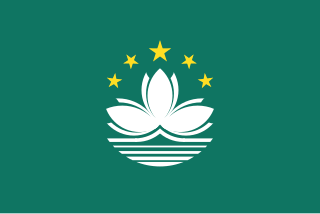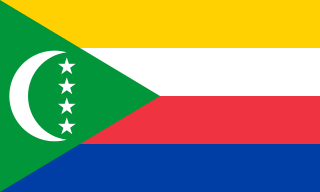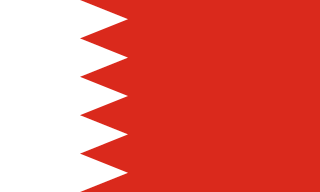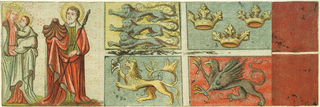
The Flag of the Department of Casanare is a symbol of the Colombian Department of Casanare.

The Flag of the Department of Casanare is a symbol of the Colombian Department of Casanare.
The flag is divided diagonally from the upper-fly corner to the lower-hoist corner. The upper-hoist triangle is red and the lower-fly triangle, green. At the center of the flag is an eight pointed sun in yellow. [1]

The flag of South Africa was designed in March 1994 and adopted on 27 April 1994, during South Africa's 1994 general election, to replace the previous flag used from 1928–1994.

The national flag of Romania is a tricolour. The Constitution of Romania states that "The flag of Romania is tricolour; the colours are arranged vertically in the following order from the flagpole: blue, yellow, red". The flag has a width-length ratio of 2:3; the proportions, shades of colour as well as the flag protocol were established by law in 1994, and extended in 2001. Its similarity to the flag of Chad has caused international discussion.

The national flag of the Philippines is a horizontal bicolor flag with equal bands of royal blue and crimson red, with a white, equilateral triangle at the hoist. In the center of the triangle is a golden-yellow sun with eight primary rays, each representing a province. At each vertex of the triangle is a five-pointed, golden-yellow star, each of which representing one of the country's three main island groups—Luzon, Visayas, and Mindanao. The white triangle at the hoist represents liberty, equality, and fraternity. A unique feature of this flag is its usage to indicate a state of war if it is displayed with the red side on top, which is effectively achieved by flipping the flag upside-down.

The national flag of Pakistan, also known as the Flag of the Star and Crescent, is made up of a green field with a stylized tilted white crescent moon and five-pointed star at its centre, and a vertical white stripe at its hoist-end. Though the specific shade of green on the flag is mandated only as 'dark green', its official and most consistent representation is in Pakistan green, which is shaded distinctively darker. It was adopted by the Constituent Assembly of Pakistan on 11 August 1947, and it became the official flag of the Dominion of Pakistan on 14 August 1947, following independence from the British Empire. The flag was subsequently retained as that of the Islamic Republic of Pakistan in 1956, and remains in use as the national flag to this day.

The Regional Flag of the Macau Special Administrative Region of the People's Republic of China is light green with a lotus flower above the stylised Governador Nobre de Carvalho Bridge and water in white, beneath a circular arc of five golden five-pointed stars: one large star in the center of the arc with two smaller stars on each side of the large star, each with a point angled directly outward from the center of the common circle on which they lie.

The national flag of the Union of the Comoros was designed in 2001 and officially adopted on 23 December of that year. It continues to display the crescent and four stars, which is a motif that has been in use in various forms since 1975 during the independence movement. In its constitution, the government of the Comoros refers to the insignia as l'emblème national, or the "national emblem", though it is understood to actually represent a flag.

The national flag of Bahrain consists of a white band on the left, separated from a red area on the right by five triangles that serve as a serrated line. The five white triangles symbolize the five pillars of Islam, the red on the flag represents the blood of the martyrs and the battles of Bahrain, and the white represents peace. It is sometimes mistaken for the flag of Qatar, but the latter flag is maroon, has nine points and normally has a much greater length-to-width ratio.

The national flag of Bhutan is one of the national symbols of Bhutan. The flag features a Chinese dragon from Bhutanese mythology. This alludes to the Dzongkha name of Bhutan – Druk Yul – as well as the Drukpa Lineage of Tibetan Buddhism, which is the dominant religion of Bhutan.

The flag of Eritrea is the national flag of Eritrea. It was adopted on 5 December 1995. The flag combines the basic layout and colors from the flag of the Eritrean People's Liberation Front with an emblem of a wreath and an upright olive-branch derived from the Eritrean flag from 1952 to 1962.

The national flag of Lithuania consists of a horizontal tricolour of yellow, green, and red. It was adopted on 25 April 1918 during Lithuania's first period of independence from 1918 to 1940, which ceased with the occupation first by the Soviet Union, and then by Nazi Germany (1941–1944). During the post-World War II Soviet occupation, from 1945 until 1988, the Soviet Lithuanian flag consisted first of a generic red Soviet flag with the name of the republic, in 1953 that was changed to the red flag with white and green bands at the bottom.

The flag of Namibia consists of a red diagonal band edged in two white bands with a blue upper triangle charged with an 12-ray yellow sun and green lower triangle.

The flag of Panama was made by María de la Ossa de Amador and was officially adopted by the "ley 48 de 1925". The Panamanian flag day is celebrated on November 4, one day after Panamanian separation from Colombia, and is one of a series of holidays celebrated in November known as the Fiestas Patrias.

The flag of Saint Kitts and Nevis consists of a yellow-edged black band containing two white stars that divides diagonally from the lower hoist-side corner, with a green upper triangle and red lower triangle. Adopted in 1983 to replace the flag of Saint Christopher-Nevis-Anguilla, it has been the flag of the Federation of Saint Kitts and Nevis since the country gained independence that year. Although the flag utilises the colours of the Pan-Africanist movement, the symbolism behind them is interpreted differently. The three islands later became part of the West Indies Federation in 1958; after this dissolved four years later, they were granted the status of associate state as Saint Christopher-Nevis-Anguilla. However, Anguilla decided to secede from the federation in 1969, owing to fears that their population, which was already small, would be further marginalised in parliament. This was eventually formalised in 1980, and a new flag for the remaining parts of the federation was needed, since the symbolism of the previous flag centred on the concept of a union of three.

The current eight-star flag of Venezuela was introduced in 2006. The basic design includes a horizontal tricolour of yellow, blue, and red, dating to the original flag introduced in 1811, in the Venezuelan War of Independence.

A maritime flag is a flag designated for use on ships, boats, and other watercraft. Naval flags are considered important at sea and the rules and regulations for the flying of flags are strictly enforced. The flag flown is related to the country of registration: so much so that the word "flag" is often used symbolically as a metonym for "country of registration".

The seal of the president of the Philippines is a symbol used to represent the history and dignity of the president of the Philippines. Its original form was designed by Captain Galo B. Ocampo, secretary of the Philippine Heraldry Committee, and patterned after the seal of the president of the United States. It was first used by President Manuel Roxas in 1947.

French Guiana, an overseas region and department of France located in South America, has no official flag of its own. A flag with green and yellow fields, separated by a diagonal border, with a red star at the center is often used as an unofficial flag. As an integral part of France, it flies the French flag as its national flag.
The flag and the coat of arms of Johor are state symbols of Johor, Malaysia. Like other states of Malaysia with Malay royalties, the state symbols of Johor are influenced by Johor's royalties, as well as Islam and the political and natural features of the state.

The flag of Tulsa consists of an upper navy blue half and a lower beige half, separated by a gold horizontal line, with a gold Osage shield punctuating the left third. The shield contains a red circle, and a beige six-pointed star centered within the circle. The flag is notable for being one of the few modern flags to utilize beige in its design - a color often associated with faded dyes on flags from usage.

The flag of Gdańsk features a golden five-point crown and two square white crosses, all arranged vertically on the hoist side of the flag. It uses a 5:8 proportion. The flag, in various forms, has represented the Polish city of Gdańsk since the 13th century. It was formally adopted by the Gdańsk City Council in its current form for the first time on 1 August 1996.